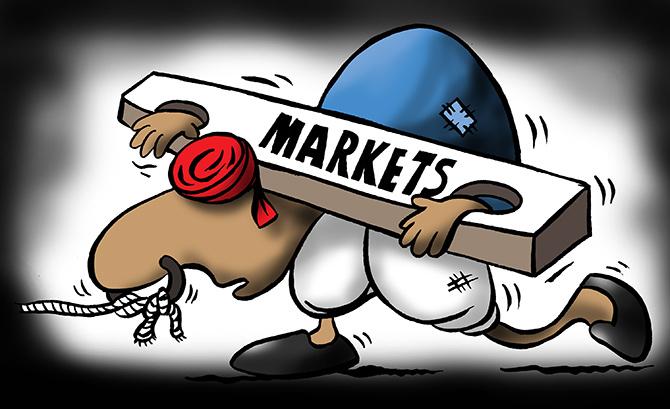Stretched valuations and slowdown in DII flows are some of the reasons why Goldman Sachs cut its India rating to 'market-weight'
Illustration: Uttam Ghosh/Rediff.com

After remaining “strategically overweight” on Indian equities since 2014, global research and brokerage firm Goldman Sachs has cut its India rating to “market-weight” from “over-weight”.
It expects the markets to consolidate ahead of the general elections and maintains a 12-month Nifty50 target of 12,000, which is over 5 per cent higher than the current levels.
Indian equities, it says, have doubled over the past five years and have outperformed the region by 60 percentage points (pp) in dollar terms.
“Given the elevated valuations and the recent strong performance, we believe the risk/reward for Indian equities is less favourable at current levels,” wrote Sunil Koul of Goldman Sachs in a recent co-authored report.
While a less stable government at the Centre as an outcome of the general elections scheduled for 2019 is a key downside risk, any upside in corporate profits and a stronger foreign institutional (FII) inflow could surprise the markets positively, Goldman Sachs says.
In terms of sectors, it has upgraded defensives and exporters and remains overweight on private banks, technology and metals.
Rural recovery and housing plays, GARP (growth at reasonable price) and beneficiaries from the rupee’s slide against the US dollar are some of Goldman Sachs’ key investment ideas.
Here are the five key reasons why Goldman Sachs has downgraded Indian equities:
Stretched valuations
Indian equities, Goldman Sachs believes, are the most expensive in Asia (27x average price-to-earnings) and are trading at a 58 per cent premium to region.
At these levels, it says, equities have historically posted a negative return over three-six months.
Macro headwinds
Tighter financial conditions, weak activity data and higher oil prices (in rupee terms) are likely to see economic growth moderate, analysts at Goldman Sachs say.
They forecast a current account deficit (CAD) at 2.6 per cent of GDP (gross domestic product) versus 1.9 per cent in financial year 2017-18 (FY18) and expect the crude oil prices to remain elevated at $80 per barrel in the next three months.
Earnings recovery priced in
Despite unfavourable macros, Goldman Sachs says the markets have priced in growth in corporate earnings at the current levels.
“Nifty has compounded at 14 per cent over the past five years while earnings grew at 5 per cent. While profit recovery is underway, this micro ‘catch up’ doesn’t warrant a further upside.
"Indian equities are pricing in a 17 per cent 10-year earnings growth on a compounded basis (CAGR) - the highest in the region,” the Goldman report says.
Slowdown in DII flows
Even though domestic flows have slowed for four consecutive months, Goldman Sachs believes funds could potentially see lower equity inflows, as the yield gap between equities and bonds has dipped to a 10-year low.
Event risk
Lastly, the report cites “event risk” arising from likely increase in government spending/fiscal deficit ahead of the elections and possibility of a less stable government weighing on the markets in the near term.











